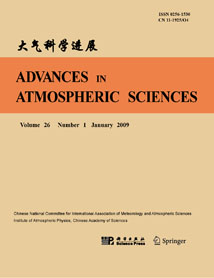| [1] |
Luo Dehai,
1999: Bifurcation of Nonlinear Kelvin Wave-CISK with Conditional Heating in a Truncated Spectral Model: A Possible Mechanism of 30-60-Day Osculation at the Equator, ADVANCES IN ATMOSPHERIC SCIENCES, 16, 279-296.
doi: 10.1007/BF02973088
|
| [2] |
Hengyi WENG,
2012: Impacts of Multi-Scale Solar Activity on Climate. Part I: Atmospheric Circulation Patterns and Climate Extremes, ADVANCES IN ATMOSPHERIC SCIENCES, 29, 867-886.
doi: 10.1007/s00376-012-1238-1
|
| [3] |
Huang Ronghui, Wu Yifang,
1989: The Influence of ENSO on the Summer Climate Change in China and Its Mechanism, ADVANCES IN ATMOSPHERIC SCIENCES, 6, 21-32.
doi: 10.1007/BF02656915
|
| [4] |
Peng Jiayi, Wu Rongsheng, Wang Yuan,
2002: Initiation Mechanism of Meso-β Scale Convective Systems, ADVANCES IN ATMOSPHERIC SCIENCES, 19, 870-884.
doi: 10.1007/s00376-002-0052-6
|
| [5] |
Qin Jianchun, Zhu Baozhen,
1986: A STUDY ON THE EXCITATION, ESTABLISHMENT AND TRANSITION OF MULTIPLE EQUILIBRIUM STATES PRODUCED BY NEARLY RESONANT THERMAL FORCING-PART II: THEORETICAL ANALYSIS OF THE MECHANISM OF MULTIPLE EQUILIBRIUM STATES, ADVANCES IN ATMOSPHERIC SCIENCES, 3, 397-405.
doi: 10.1007/BF02657930
|
| [6] |
Ni Yunqi, Zhang Qin, Li Yuedong,
1991: A Numerical Study of the Mechanism for the Effect of Northern Winter Arctic Ice Cover on the Global Short-Range Climate Evolution, ADVANCES IN ATMOSPHERIC SCIENCES, 8, 489-498.
doi: 10.1007/BF02919271
|
| [7] |
FANG Changfang*, WU Lixin, and ZHANG Xiang,
2014: The Impact of Global Warming on the Pacific Decadal Oscillation and the Possible Mechanism, ADVANCES IN ATMOSPHERIC SCIENCES, 31, 118-130.
doi: 10.1007/s00376-013-2260-7
|
| [8] |
Bing XIE, Hua ZHANG, Zhili WANG, Shuyun ZHAO, Qiang FU,
2016: A Modeling Study of Effective Radiative Forcing and Climate Response Due to Tropospheric Ozone, ADVANCES IN ATMOSPHERIC SCIENCES, 33, 819-828.
doi: 10.1007/s00376-016-5193-0
|
| [9] |
WANG Zhili, ZHANG Hua, SHEN Xueshun,
2011: Radiative Forcing and Climate Response Due to Black Carbon in Snow and Ice, ADVANCES IN ATMOSPHERIC SCIENCES, 28, 1336-1344.
doi: 10.1007/s00376-011-0117-5
|
| [10] |
Wu Rongsheng, Fang Juan,
2001: Mechanism of Balanced Flow and Frontogenesis, ADVANCES IN ATMOSPHERIC SCIENCES, 18, 323-334.
doi: 10.1007/BF02919313
|
| [11] |
Yating ZHAO, Ming XUE, Jing JIANG, Xiao-Ming HU, Anning HUANG,
2024: Assessment of Wet Season Precipitation in the Central United States by the Regional Climate Simulation of the WRFG Member in NARCCAP and Its Relationship with Large-Scale Circulation Biases, ADVANCES IN ATMOSPHERIC SCIENCES, 41, 619-638.
doi: 10.1007/s00376-023-2353-x
|
| [12] |
Zhu Zhengxin, Xiao Jie,
1986: NUMERICAL EXPERIMENTS ON DYNAMIC MECHANISM OF BLOCKING, ADVANCES IN ATMOSPHERIC SCIENCES, 3, 105-114.
doi: 10.1007/BF02680049
|
| [13] |
XU Wenhui, NI Yunqi, WANG Xiaokang, QIU Xuexing, BAO Xinghua, JIN Wenyan,
2011: A Study of Structure and Mechanism of a Meso-beta-scale Convective Vortex and Associated Heavy Rainfall in the Dabie Mountain Area Part I: Diagnostic Analysis of the Structure, ADVANCES IN ATMOSPHERIC SCIENCES, 28, 1159-1176.
doi: 10.1007/s00376-010-0170-5
|
| [14] |
Wan Jun, Yang Fanglin,
1990: The Phenomena of Bifurcation and Catastrophe of Large-Scale Horizontal Motion in the Atmosphere under the Effect of Rossby Parameter, ADVANCES IN ATMOSPHERIC SCIENCES, 7, 409-422.
doi: 10.1007/BF03008871
|
| [15] |
Kate M. WILLETT,
2023: HadISDH.extremes Part I: A Gridded Wet Bulb Temperature Extremes Index Product for Climate Monitoring, ADVANCES IN ATMOSPHERIC SCIENCES, 40, 1952-1967.
doi: 10.1007/s00376-023-2347-8
|
| [16] |
Gao Shouting,
1991: A-B Hybrid Equation Method of Nonlinear Bifurcation in Wave-Flow Interaction, ADVANCES IN ATMOSPHERIC SCIENCES, 8, 165-174.
doi: 10.1007/BF02658092
|
| [17] |
Huqiang ZHANG, LI Yaohui, GAO Xuejie,
2009: Potential Impacts of Land-Use on Climate Variability and Extremes, ADVANCES IN ATMOSPHERIC SCIENCES, 26, 840-854.
doi: 10.1007/s00376-009-8047-1
|
| [18] |
Tianjun ZHOU, Wenxia ZHANG, Lixia ZHANG, Robin CLARK, Cheng QIAN, Qinghong ZHANG, Hui QIU, Jie JIANG, Xing ZHANG,
2022: 2021: A Year of Unprecedented Climate Extremes in Eastern Asia, North America, and Europe, ADVANCES IN ATMOSPHERIC SCIENCES, 39, 1598-1607.
doi: 10.1007/s00376-022-2063-9
|
| [19] |
Wenxia ZHANG, Robin CLARK, Tianjun ZHOU, Laurent LI, Chao LI, Juan RIVERA, Lixia ZHANG, Kexin GUI, Tingyu ZHANG, Lan LI, Rongyun PAN, Yongjun CHEN, Shijie TANG, Xin HUANG, Shuai HU,
2024: 2023: Weather and Climate Extremes Hitting the Globe with Emerging Features, ADVANCES IN ATMOSPHERIC SCIENCES.
doi: 10.1007/s00376-024-4080-3
|
| [20] |
HUANG Feng, LIU Shikuo,
2004: Physical Mechanism and Model of Turbulent Cascades in a Barotropic Atmosphere, ADVANCES IN ATMOSPHERIC SCIENCES, 21, 34-40.
doi: 10.1007/BF02915678
|















 AAS Website
AAS Website 
 AAS WeChat
AAS WeChat 
 DownLoad:
DownLoad: